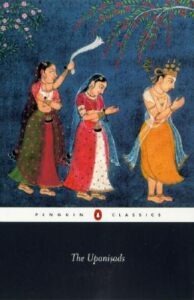The Upanishads are a collection of sacred Sanskrit texts that were written over the course of a few centuries. Which texts were written in which centuries is a hotly debated question, but according to Valerie J. Roebuck, the translator and editor of the Penguin edition pictured above, the “consensus view” is that “the principal Upanishads were composed from about 700 BCE, perhaps incorporating some older material. The early prose Upanishads could well date from about 700-400 BCE, the verse Upanishads two or three centuries later, and the Prasna and Mandukya from the end of the last millennium BCE. The Maitri could have been put into its present form as late as the second or third century BCE” (p. 27).
Like the Rig Veda and other religious Sanskrit texts, the Upanishads are often written in the form of riddles, paradoxes, wordplay, and dialogues. Each begins with an invocation, such as this – “OM. That is full; this is full; Fullness comes forth from fullness: When fullness is taken from fullness, Fullness remains. OM. Peace, peace, peace” (p. 63) – which demonstrates, even in English translation, the repetition so commonly used in Sanskrit texts that are meant to be memorized and chanted. I talked a little bit about the repetitive nature of Sanskrit oral literature in my Update on Sanskrit post last week.
One oft-repeated verse throughout the Upanishads is this:
They who worship ignorance
Enter blind darkness:
They who delight in knowledge
Enter darkness, as it were, yet deeper. (p. 64)
Roebuck explains that the meaning of this riddle is probably that “‘ignorance’ (ritual action without understanding) and ‘knowledge’ (understanding without action) are both inadequate, but the latter is more dangerous because the one who relies on it is more likely to believe that it is sufficient in itself” (p. 450). A later verse clarifies, “Whoever knows knowledge and ignorance – Both of them, together – By ignorance crosses over death. And by knowledge reaches immortality” (p. 65). That this teaching is returned to several times stresses the importance in Hindu philosophy of balancing opposing forces and finding harmony between them.
I encourage you to read these ancient teachings yourself if you haven’t already. If you have, what are some of the verses or teachings that stood out to you? I would love to hear from you in the comments below.
I hope you have enjoyed spending this month delving into the Sanskrit language and literature. Please join me next month (March 2025) in learning about Old Chinese and Ancient Chinese and some of their greatest texts, most particularly the I Ching and Tao Te Ching. Happy reading!
Source used:
The Upanishads (Penguin Classics). Edited and translated by Roebuck, Valerie J. Penguin Books Ltd. Kindle Edition.
